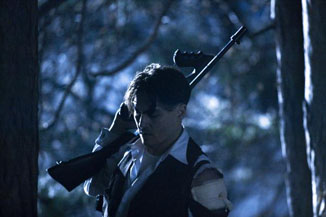Book vs. Movie: Public Enemies
By Russ Bickerstaff
July 8, 2009
In this corner: the Book. A collection of words that represent ideas when filtered through the lexical systems in a human brain. From clay tablets to bound collections of wood pulp to units of stored data, the book has been around in one format or another for some 3,800 years.
And in this corner: the Movie. A 112-year-old kid born in France to a guy named Lumiere and raised primarily in Hollywood by his uncle Charlie "the Tramp" Chaplin. This young upstart has quickly made a huge impact on society, rapidly becoming the most financially lucrative form of storytelling in the modern world.
Both square off in the ring again as Box Office Prophets presents another round of Book vs. Film.
Public Enemies
Author Bryan Burrough had been interested in the early days of J. Edgar Hoover's FBI. When he started looking into it, he found that there were very few books dedicated to an objective, journalistic look at the Bureau's origins. Books had been written on various criminals that had been targeted by a fledgling FBI, but nothing focusing on the Bureau itself. Digging a little further, he found out that there were a number of documents from the dawn of the FBI that had been declassified in the ‘80s. No book had been written on the subject since. Burrough decided to write the first ever book to take a comprehensive, chronological look at both the early days of the FBI and the first men that it had targeted in the first ever war on crime - Public Enemies. Years later, the book has become a critical and financial success, prompting a big-budget film adaptation directed by Michael Mann that has been released this month. How does the first historical gangster film of the 21st century compare with the book it's based on?
The Book
Bryan Burrough set out not only to outline the major events involved in the birth of the FBI and its first targets, he also wanted to tell a comprehensive story of the period with details that often get overlooked. In fewer than 600 pages, we see a chronological account of events running from June 8, 1933 through January 20, 1935. In it, we see a desk-bound bureaucrat named J. Edgar Hoover who struggles to establish a national law enforcement organization. He's hiring fresh-faced kids right out of law school who have absolutely no background in law enforcement whatsoever. A neat, professional environment is rigidly enforced complete with dress code. When a hail of gunfire massacred a group of lawmen in Kansas City on June 17th, the group that was to become the FBI was galvanized. Hoover declared war on crime. The Bureau started hiring experienced lawmen from Texas — cowboys who would help the inexperienced kids manage some of the first successes of what was to become the FBI we know today.
All of this background about the FBI is terribly interesting, impressively detailed and on the whole, very, very well written. Burrough writes non-fiction with the aesthetic of a best-selling novelist. The action of the book, all of which has been painstakingly researched and sited, comes across in both clear, journalistic factual detail AND the somewhat acrobatic pseudo-poetry of hardboiled action fiction.
Continued:
1
2
3




